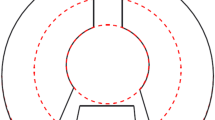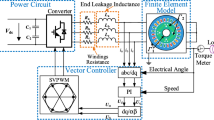Abstract
The objective of this paper is to improve the performance estimation model of the internal flow field of a torque converter. Compared with performance experiment results, the converter based on the one-dimensional model does not satisfy the performance requirements demanded in practice. Therefore, we need to develop more predictable and reliable performance estimation models. In order to obtain shape information on three-dimensional blade geometry, a process of reverse engineering conducts a torque converter assembly, impeller, turbine and stator. In addition, a CFD simulation including mesh generation and post-processing was carried out to extract equivalent parameters from the internal flow field. The internal flow field can be explained by analyze the correlation between a performance estimation model and CFD analysis. The equivalent performance model adopts the variation of energy loss coefficients for a given operating condition according to the application of a changing energy loss coefficient by the least mean squares method. The estimated equivalent model improves the agreement in performance between experiments and the theoretical model. This model can reduce the error to within about 3 percent. Furthermore, this procedure for predicted performance achieves eminence in the estimation of the capacity factor.
Similar content being viewed by others
Abbreviations
- I:
-
moment of inertia, kgm2
- T:
-
torque, Nm
- ω :
-
angular speed, rad/s
- V:
-
velocity of global coordinates, m/s
- u:
-
rotating speed of local coordinates, m/s
- A:
-
area, m2
- CF:
-
the capacity factor, T 2 p /ω 2 p , Nm/rpm2
- TR:
-
the torque ratio,T T /T P
- sr:
-
speed ratio, ω T /ω P
- R:
-
mean radius, m
- Q:
-
volume flow rate, m3/s
- ρ :
-
fluid density, kg/m3
- C F :
-
friction energy loss coefficient
- C sh :
-
shock energy loss coefficient
- α :
-
blade angle, rad
- OPM:
-
the one dimensional performance model
- EPM:
-
the equivalent performance model
- EEM:
-
the estimated equivalent performance model
- i:
-
element (impeller, turbine, stator)
- P:
-
pump, impeller
- T:
-
turbine
- S:
-
stator
- I:
-
inlet
- O:
-
outlet
Refrences
Abe, K.-I. and Kondoh, T. (1991). Three-dimensional simulation of the flow in a torque converter. SAE Paper No. 910800.
Cigarini, M. and Jonnavithula, S. (1995). Fluid flow in an automotive torque converter: Comparison of numerical results with measurements. SAE Paper No. 950673.
Dong, Y., Lakshminarayana, B. and Maddock, D. (1998). Steady and unsteady flow field at pump and turbine exit of a torque converter. ASME J. Fluid Engineering, 120, 538–548.
Dong, Y., Korivi, V., Attibele, P. and Yuan, Y. (2002). Torque converter CFD engineering Part 1: Torque ratio and K factor improvement through stator modifications. SAE Paper No. 2002-01-0883.
Gruver, J. K., Flack, R. D. and Brun, K. (1996). Laser velocimeter measurements in the pump of an automotive torque converter: Part I — Average measurements. ASME J. Turbomachinery, 118, 562–569.
Hrovat, D. and Tobler, W. E. (1985). Bond graph modeling and computer simulation of automotive torque converter. J. Franklin Institute 391,1/2, 93–114.
Ishihara, T. and Emori, R. I. (1966). Torque converter as a vibration damper and its transient characteristics. SAE Paper No. 660368.
Jandasek, V. (1961). Design of single-state, three element torque converter. Design Practices: Passenger Car Automatic Transmission, 3rd edn., SAE, 103–108.
Lee, C. W., Jang, W. J. and Lim, W. S. (2000). Three dimensional flow field simulations to estimate performance of a torque converter. SAE Paper No. 2000-01-1146.
Minato, K., Sakamoto, K., Takagi, M. and Fujitani, K. (1990). A performance prediction of hydrodynamic torque converter. SAE Paper No. 900555.
Pohl, B. (2003). Transient torque converter performance, testing, simulation and reverse engineering. SAE Paper No. 2003-01-0249.
Robert, R. and Mahoney, J. E. (1988). Technology needs for the automotive torque converter-Part 1: Internal flow, blade design and performance. SAE Paper No. 880482.
Software Cradle Co., Ltd. (2005). SC/Tetra Version 6 User’s Guide Basics of CFD Analysis. 3–8.
Von Backstrom, T. W. and Lakshminarayana, B. (1996). Perspective: Fluid dynamics and performance of automotive torque converters: An assessment. ASME J. Fluid Engineering, 118, 665–676.
Watanabe, H., Kurahashi, T. and Kojima, M. (1997). Flow visualization and measurement of torque converter stator blades using a laser sheet lighting method and a laser doppler velocimeter. SAE Paper No. 970680.
Author information
Authors and Affiliations
Corresponding author
Rights and permissions
About this article
Cite this article
Kim, B.S., Ha, S.B., Lim, W.S. et al. Performance estimation model of a torque converter part I: Correlation between the internal flow field and energy loss coefficient. Int.J Automot. Technol. 9, 141–148 (2008). https://doi.org/10.1007/s12239-008-0018-5
Received:
Revised:
Published:
Issue Date:
DOI: https://doi.org/10.1007/s12239-008-0018-5




